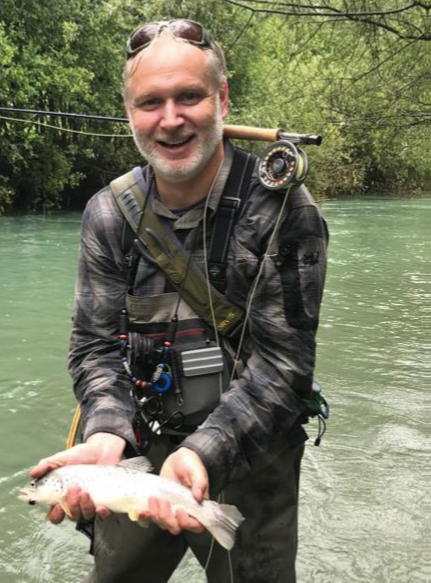"I draw strength and peace from my hobby. For me, it is the best balance to my family and my daily work as the managing director of Ginesta Verwaltungen AG."

The morning and the evening is the time of fly-fishing. This is when the fish become more active, leave their hiding place under the cover of dusk and hunt for food in shallow water near the shore. During the day they are shy and stay in shady, deeper places. But when the sun goes down, smaller and larger circular waves show their activity in the water. Fly fishers call this range between day and night the "leap of the evening hour".
Fly fishing is an ancient way of catching fish. Already in more than 2000 years old Greek writings one finds references to artificial flies made of pieces of fur and feathers. At first, fishing was done with a line only, later on rod and reel were added, on which the line is wound up. For a long time this form of fishing was considered an exclusive, elite hobby for men of the upper class. What English aristocrats at that time called "recreation for the thoughtful man", however, developed more and more into a recognized and popular trend sport for men - and women. It is now estimated that more than one million women worldwide have discovered this outdoor pleasure for themselves, which corresponds to about 15 to 20 percent of all fly fishers.
Fly Fishing
Among others, the Swiss Charles Ritz (1891-1976) revolutionized fly fishing. Ritz was not only a famous hotelier, but above all a passionate fly fisherman. Thus he also fished together with the writer Ernest Hemingway, who became world famous for his novella "The Old Man and the Sea", among other things. Hemingway wrote the foreword in the book "Erlebtes Fliegenfischen" by Charles Ritz - it is still considered the "bible" of the guild. Today, fishing is done with very light and slim rods made of carbon fibre, which are equipped with a cork handle. Hooks without barbs are used, which are less likely to injure the animal and can thus be gently put back into the water.
The fly - insects are the natural food of fish - is mainly used to catch fish in flowing waters. So-called salmonid-like fish such as trout, char, grayling and salmon are fished with them. It does not require much strength. Important are casting technique, patience, attention and the gift of doing the right thing at the right moment. And, of course, stability is also required, for example when positioning yourself in the middle of torrents. You should not be on your own during risky manoeuvres.
Dealing with nature
A skilled fly fisherman spends a lot of time observing the environment. He usually has a knowledge of fish biology, studies the life of insects, has an insight into the chemistry and physics of the water and pays attention to the weather, wind and water level. Fly fishers are all-round talents who are always discovering new things. We fly fishers attach great importance to catching fish in the most careful way possible. The interaction with nature and the cautious way of fishing are also what fascinates me so much about fly fishing. In addition, there is the meditative aspect of fly fishing, which for me is an important balance to my daily work.
About 20 years ago the well-known Swiss fly fisherman Hans-Ruedi Hebeisen introduced me to fly fishing at a course. It didn't take long before I was able to acquire the optimal casting technique with all its special and trick casts. Today I enjoy my hobby most of all at torrents and rivers in Switzerland, Austria and the Black Forest. The feeling is indescribable when you can cast a stately trout on sight and see the fish rising after the fly and taking it. Besides the perfect cast, the most important thing is how to present the fly to the fish. You have to believe a little bit in your fly and have a lot of patience. Fly fishing is the art of seduction.
Artificial flies attract fish
The bait used is not real flies but artificial flies. Tying is an art in itself. The author Juliana Berners (born around 1400) of the first reference book "A Treatise of Fishing with an Angle" already knew this. Here Juliana Berners describes how to reproduce artificial flies from natural materials such as feathers and skins as lifelike as possible. Tying the artificial insects requires dexterity, imagination and craftsmanship. Natural prey of the fish such as flying, land and water insects are imitated. Sometimes I also experiment with my own, freely invented creations. For me, fly tying has become a beloved activity on winter evenings, where I can dream of the beautiful hours by the water.
Tradition and exclusivity
If you look at the exclusive rods, reels, clothing and well-kept material, fly fishing may seem like an elitist, expensive sport. But in reality, for this sport you need nothing more than a fly rod, a fly line, a reel and a so-called leader. The main task of the leader is to create a smooth transition from the relatively thick fly line to the hook eye. Every fly fisherman sooner or later succumbs to the lure of an exclusive rod from England, the motherland of fly fishing. It is therefore not surprising that English rod manufacturers pay attention to tradition and exclusivity.
"In fly fishing as well as in your job, you need patience, respect and the skill to do the right thing at the right moment.
Fly fishing is not about quantity, but about experience."
|
|
Hier finden Sie den ganzen Artikel zum Download als PDF.










